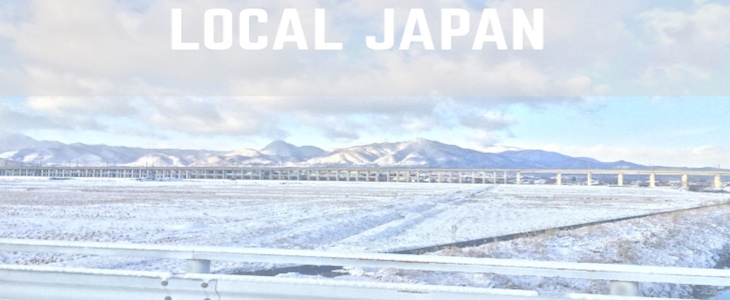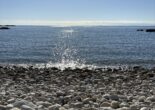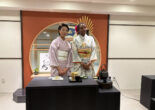
“Where are you in Japan? I’m visiting there. Let’s meet.” Every time I hear these words from Filipino friends or students whom I taught in a Korean academy before as an English teacher, I always tell them, “Don’t expect to meet me because I’m so far away from Tokyo,” with a sad face. It takes 8 hours by night bus or 3 hours by shinkansen (bullet train) to come here. What can I do? I was placed to work here in Morioka City, the capital city of Iwate. Yes, that’s right, a prefecture just below Hokkaido.
It has been a year since I last moved to Japan. I came from the Pearl of the Orient Seas, the Philippines specifically Cebu where you can swim with the whale sharks. Anyway, it has been a long journey for me to be able to come here to Japan. It took me a year to apply and process all the documents needed to be here since the Philippines has a stringent and long process for Filipinos going abroad. I came here for the chance of a better future along with around 20 Filipinos placed all over Japan thinking the same thing. I was so excited the first time I came here which was on March 2017. It was Spring. We had few weeks of training at a hotel in Tokyo then we were brought to our respective areas. We rode 2 trains – one was an express train from Narita to Tokyo , then the other one was the bullet train from Tokyo to Morioka. It took approximately 3 hours. When I first arrived in Morioka, it was much colder. Imagine it was 8 degrees in Tokyo and in
Morioka, it was 3 degrees and small flakes of snow were still visible! How surprising is that for a body that comes from a tropical country!
When I first moved to my area, it was surprisingly quiet. I could see nobody. My mom saw this and asked me if where I live is a ghost town. Nevertheless, the neighborhood is beautiful and serene with a nice view of Mt. Iwate. Later, I slowly began to see some people and it brought a smile to my face. Being here for a year, I’ve realized that mostly, people “hibernate” when it’s cold. At that time, it was still cold so I couldn’t see a lot of people going out in my neighborhood.
I live in a Leopalace apartment. Fancy name, that is but it’s rather small but enough for one person to live in. I was happy as a newcomer to have a place with utilities ready, such as a washing machine, a refrigerator, an IH stove, a microwave oven, a bed frame, a futon, a table, and a chair, and most importantly a built-in wifi, so I just needed to buy few more stuffs. This was really helpful for me since I am in a non-driving assignment. We were reminded to remain as quiet as possible in the apartment because Leopalace is popular for its thin walls! I didn’t realize that until I heard my neighbors’ footsteps, bath water draining sound, and even my neighbor’s snore! Living in Iwate for a year now, I could see how quiet my community is. I fear to go out at night not because of the thought something might happen to me but because the roads are dark, and there are only a few stores that are open for 24 hours. Unless you live in the center of the city, it’s dark elsewhere. I often don’t go out at night but spend my time watching movies and dramas online.
Nevertheless, I admire Morioka for several reasons:
First, here, you can eat the big 3 noodles namely reimen, jajamen, and wankosoba! I wrote them according to my favorite. The first noodle I ever tried was reimen. Knowing that this is a cold noodle, I didn’t want to try it. But then, thinking that since I live here, I might as well try. When I tried it, it changed all my bad ideas of cold noodles! It’s super delicious! Well, that’s for me, it still depends on the person who eats it. Also, the most important thing to be able to appreciate the taste of reimen is the choice of the restaurant. I first ate it in Pyonpyonsya, a restaurant just near Morioka station, where I fell in love with reimen. I couldn’t find another place to eat delicious reimen aside from Pyonpyonsya. I have tried eating reimen in Tokyo but nothing compares to the taste of it in its origin.
The next noodle I tried was wankosoba. From the word “wanko” which means “small bowl”, you are expected to eat as much as you can! Then, I took the challenge. I had that experience with my Korean boyfriend who just made me feel so pressured because he was eating all those noodles like a bat out of hell. He was able to finish 104 bowls and I only had 40. Sad to say but we didn’t become so fond of wankosoba after having tasted it. We thought that it was only good for one try. The last big noodle I tried was jajamen. I became interested in eating jajamen because of course, since I was a newcomer, people were just talking to me to try this and that, and do this and that. I’ve heard from my colleagues who are Americans that you can only appreciate the taste of jajamen after you have eaten it thrice. They were wrong! I’m sorry guys but the first time I tasted jajamen, it suited my taste buds so well. The mixture of cucumber, grated garlic, miso, and the spices of your liking, it’s just – wonderful! But my favorite part is the last part where you leave few noodles, crack a raw egg on top, mix it with the few noodles left and they make it into a soup. They call it “chi-tan”.
Second, I like Morioka because the temperature in summer is a winner! Sometimes, the temperature is just 17 degrees. Coming from a country where the temperature doesn’t drop lesser than 25 degrees, 17 degrees is very comfortable. My other colleagues in the south usually complained how hot it was. I was even able to survive Morioka’s summer without an electric fan. I always find myself opening my eyes at 5am thinking that it is already 7am. The sun rises at 4am and the sun sets at 7pm. I felt like it was the best time of the year.
Third, as an English teacher, we are called ALTs, Assistant Language Teacher; my students are fun, kind and polite. I’m teaching high school and they have a special name for English high school teachers, NS, Native Speakers. Though technically I’m not one, it’s kind of self-boosting to be called one. ALTs here are the ones teaching elementary and junior high schools. As a high school teacher, I get to teach the whole 50-minute class. Work is not a problem at all. I usually go home not tired and with a smile on my face because of the warm and charming students. Sometimes, I pass by kids and they greet me, “Konnichiwa!” while independently walking back to their homes. Who wouldn’t smile because of these respectful cuties?
In addition, the people that surround me are very helpful. In fact, I received a bike from my fellow teacher. Our conversation started with a “Hello, how are you?” The conversation then succeeded into “How do you come to school?” When he knew that I only walk to school, without a pause, he offered to give me his bike. I was so happy. I usually just went grocery shopping on foot. There are other grocery stores nearby but I always wanted to go to Universe, a supermarket, because it offers more than just grocery shopping. It has Daiso, Shoe Plaza, clothes stores, arcade, flower shop, and the Sansa drugstore beside it, all with reasonable-priced goods. As a person in my first year in Japan, I needed a lot of things. Therefore, before I received the bike, I would walk home with heavy plastic bags left and right. When I didn’t have the bike yet, it took me 30 minutes to walk from my place to school and 20 minutes to go to Universe. So that time, I couldn’t visit more places since it took a lot of time to go from one place to another. When I had the bike, it took only 10 minutes to go to school, around 5 minutes to go to Universe, and I was already able to explore a considered farther place on foot where I discovered nearby helpful shops such as a hardware store, second-hand shops, clinics, other supermarkets, a sports center, K’s Denki (an electronics store), KFC, and other restaurants. Going around on a bike is indeed fun and helpful! My bike became my best friend. Generally, I think Japanese people are warm and helpful but, I noticed people in Iwate are much more relaxed and smiling. I was surprised in one of my trips in Tokyo when the restaurant staff didn’t even smile at us. In Morioka, I always see smiling faces and I always feel their happiness and warmth in serving. I can’t blame the people in Tokyo because they might just be too stressed with their jobs living in a demanding city. Lastly, Morioka is considered a rural area since it is situated far away from the big cities; however, Morioka doesn’t lack support groups for foreigners. Aiina, Iwate’s prefectural library has a “gaikokujin” corner or foreigners’ corner. You certainly won’t feel the anxiety of having the language barrier since their staff can speak in English. Whatever your concern is, they can help you. If you want to study Japanese, they can find you language supporters, who are Aiina’s volunteers, for free.
You may set your lesson with your supporter any time and any day you want. You may choose to have one or more language supporters. It depends how much free time you have. They also inform youabout the upcoming events so you can join and have fun. I have received advice and support from them when I applied for a Korean visa. If you want to ask about famous tourist places and information about where to rent bikes, where to find work, assistance in visa application, etc., they are surely the ones to approach.
I got lucky being placed in the capital city. It surely has a lot of things to offer. I’ve heard from my other colleagues around Iwate, who were placed in mountain areas and coastal areas, that shops and stores are hardly available. One must have a car to be able to go to places but what happens if he/she wasn’t given one? That’s when online shops like Amazon, and me and my friends’ personal favorite, Q0010 for their cheap stuffs, play their roles. I like Amazon for its delivery is fast. Sometimes, the delivery comes before the expected date.
Moving forward, fall came. I realized that I prefer and like fall the most because of the vibrant colors of leaves from turning red and yellow. Having only 2 seasons in the Philippines – dry and wet, the four seasons in Japan is interesting for me. However, I thought that people here must have a lot of clothes! Earning money, helping your family and living in an expensive country, with all the taxes and deductions from your salary, you ought not to buy a lot of clothes but it’s “shoganai” as Japanese people say it. It can’t be helped. It can’t be helped to spend money. I really needed to buy clothes, coats, and boots suitable for the season.
Everything was going well in Morioka until winter came. No more 4am sunrises. No more 7pm sunsets. In winter, sun rises at 7am, and sets at 4pm. As a person who hasn’t really experienced snow, I was in bliss. White-covered fields, white-covered mountains, white-covered streets, white-covered houses were all over the place. Everything was white. It was captivating. Well, at first.
Then, the coldness of snow slowly sank in. The gloomy sky, late sunrises, early sunsets, and the chilling cold, made me feel lonely. They were taking their toll on my body and mind. I couldn’t ride the bike anymore because the roads were filled with snow, but my students are like warriors. I call them the real Tohoku, the region Iwate belongs to, warriors, because they bike even when there’s snow. I couldn’t do the same thing because it was my first winter and I was afraid. I saw one of my students fell down while riding his bike. The roads are that slippery. The 30-minute walk going to school became a 1-hour walk when the roads became ice. I usually had free ice skating in winter. I actually enjoyed walking in snow since I can take some time to pause and just admire the white-covered scenery of Morioka.
Morioka is known for having a lot of snow and long winter. Snow starts to fall in December and snow stops falling in March. The lowest temperature I experienced was -15 degree Celsius. Going to onsens, hot springs, became my refuge. Last winter was my first time to go to an onsen with my friends. Being it the first time, I was worried and embarrassed but later on, I’ve come to love going to onsens so much especially in winter.
Without the extreme cold and lots of snow, I think Morioka is a very nice place to live in. It’s surrounded by beautiful relaxing nature and good people. Usually, I leave my bike with the key on it and it has never been stolen. Also, because the place is very clean and unpolluted, the people here drink tap water; thus, helping you save money from buying water.
For sure here in Morioka, it’s totally different from Tokyo because in Tokyo you are surrounded with a lot of buildings but here, your eyes will adore the wide vast green fields in summer and because Morioka is the capital city, I think there’s a balance of nature and buildings. It totally depends on a person which environment they choose to live in: a busy and crowded city like Tokyo, or a serene and quiet, cool and cold city like Morioka?
Written by Marie Antonette Alicaba
Related Articles
Wanna Sniff Animal Butts? Visit ATOA Aquarium — The Most Unique Aquarium in Kansai, Japan!
Warning: Undefined array key "sfsi_threadsIcon_order" in /home/veremosglobal/tokyoroomfinder.com/public_html/blog/wp-content/plugins/ultimate-social-media-icons/libs/controllers/sfsi_frontpopUp.php on line 165
Warning: Undefined array key "sfsi_blueskyIcon_order" in /home/veremosglobal/tokyoroomfinder.com/public_html/blog/wp-content/plugins/ultimate-social-media-icons/libs/controllers/sfsi_frontpopUp.php on line 170
Warning: Undefined array key "sfsi_bluesky_display" in /home/veremosglobal/tokyoroomfinder.com/public_html/blog/wp-content/plugins/ultimate-social-media-icons/libs/controllers/sfsi_frontpopUp.php on line 266



